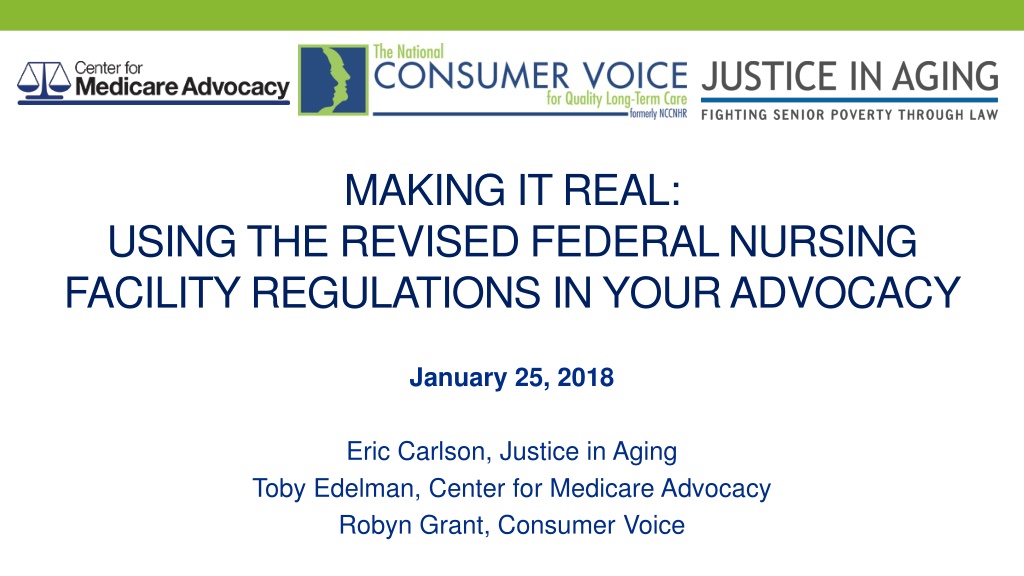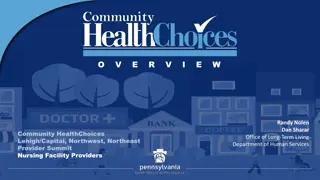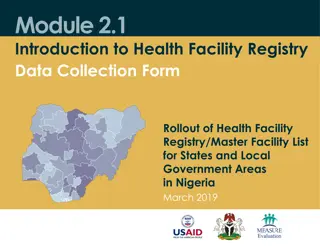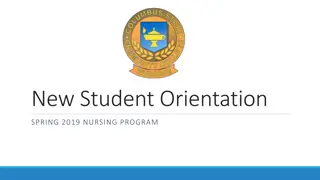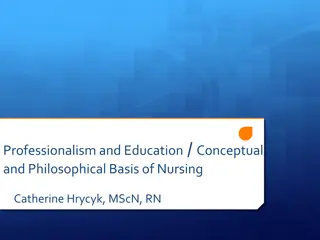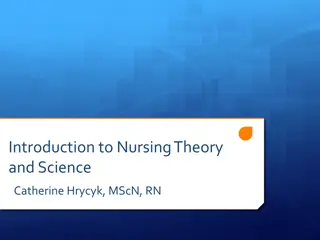Understanding the Revised Federal Nursing Facility Regulations
This session explores the implications of the revised Federal Nursing Facility Regulations, including the reasons for the comprehensive revisions, the three implementation phases, and the key changes in Phase One and upcoming Phase Two. The focus is on how these regulations impact residents' rights, care planning, quality of life and care, and various services provided in nursing facilities.
Download Presentation

Please find below an Image/Link to download the presentation.
The content on the website is provided AS IS for your information and personal use only. It may not be sold, licensed, or shared on other websites without obtaining consent from the author. Download presentation by click this link. If you encounter any issues during the download, it is possible that the publisher has removed the file from their server.
E N D
Presentation Transcript
MAKING IT REAL: USING THE REVISED FEDERAL NURSING FACILITY REGULATIONS IN YOUR ADVOCACY January 25, 2018 Eric Carlson, Justice in Aging Toby Edelman, Center for Medicare Advocacy Robyn Grant, Consumer Voice
Agenda Introductions Robyn Grant, Director of Public Policy & Advocacy, Consumer Voice Overview Toby Edelman, Senior Policy Attorney, Center for Medicare Advocacy Case Scenarios Eric Carlson, Directing Attorney, Justice in Aging Toby Edelman, Senior Policy Attorney, Center for Medicare Advocacy Q & A Closing Robyn Grant, Director of Public Policy & Advocacy, Consumer Voice
Overview, Requirements of Participation Revised Requirements of Participation (RoPs), 81 Fed. Reg. 68688 (Oct. 4, 2016), replace RoPs published Sep. 26, 1991, 56 Fed. Reg. 48826.
Overview CMS describes reasons for comprehensive revisions: Nursing home population is more diverse, more clinically complex Substantial advances have been made in theory and practice of service delivery [E]liminate or significantly reduce those instances where the requirements are duplicative, unnecessary, and/or burdensome (page 68689) Align with HHS Quality Initiatives (high quality of care, improved care, lower cost)
Three Phases to Implementation of Final Rules Phase One: Nov. 28, 2016 Phase Two: Nov. 28, 2017 Phase Three: Nov. 28, 2019
Phase One Phase 1: Nov. 28, 2016 RoPs from existing RoPs, which CMS redesignates and frequently revises (pp. 68825-68831) Includes most residents rights; admission, transfer, discharge; care planning; quality of life; quality of care; physician services; nursing services; pharmacy services; dental; food and nutrition; administration; infection control Important point: Most of this language is identical to prior Requirements (in effect for 25 years), or very similar, or moved from surveyor guidance These are NOT NEW requirements for facilities.
Phase Two Phase 2: Nov. 28, 2017 New RoPs and more complex issues Includes Baseline care plan Facility assessment process to determine number and competency of needed staff Behavioral health services Medical chart review in pharmacy Facility policy for replacing dentures Antibiotic stewardship (infection control)
Phase Three Phase 3: Nov. 28, 2019 Completion of implementation Includes Trauma-informed care Quality Assessment and Performance Improvement (QAPI), required by Affordable Care Act (ACA) to be implemented by CMS by Dec. 31, 2011, and by facilities, by Dec. 31, 2012 Compliance and Ethics Programs, required by ACA to be implemented by facilities 2013 Call system for each resident bedside New training requirements
Requirements Were Not Repealed in Their Entirety Under Congressional Review Act, 5 U.S.C. 801-808, Pub. L. 104-121 (part of Gingrich s Contract with America), 251 Allows Congress/President to overturn major rules; 60 legislative days Joint resolution of disapproval (signed by President) But CMS is proposing to repeal some Requirements and has undermined enforcement
CMS (Current Administration) Requirements of Participation NPRM to allow pre-dispute mandatory arbitration, 82 Fed. Reg. 26649 (Jun. 8, 2017)(reversing prohibition in revised Requirements published Oct. 2016). Announces review of Requirements in annual update to Medicare SNF reimbursement, 82 Fed. Reg. 21014, 21089 (May 4, 2017), specifically Grievance process, 42 C.F.R. 483.10(j) Quality Assurance and Performance Improvement, 483.75 Discharge notices, 483.15(b)(3)(i) Delays enforcement of Phase 2 Requirements for a year, S&C: 17-36-NH (Jun. 30, 2017) ( Revisions to State Operations Manual (SOM) Appendix PP for Phase 2, F-Tag Revisions, and Related Issues ), https://www.cms.gov/Medicare/Provider-Enrollment-and- Certification/SurveyCertificationGenInfo/Downloads/Survey-and-Cert-Letter-17-36.pdf.
While the Rules Are Here . . . We ll use them as much as we can Both the specifics of what the rules say, with new emphases on Person-centered care, meaning resident choice, control, preferences Professional standards of practice (facilities cannot rely on corporate policy); and what surveyor guidance (State Operations Manual, Appendix PP) says. SOM is subregulatory, but official, guidance from CMS, explaining what law and regulations mean.
PROBLEM: RESIDENT SEEMS TO SIGN AWAY RIGHTS IN ADMISSION AGREEMENT
No Waiver of Rights Admission agreement cannot waive federal, state, or local law. Includes rights to coverage under Medicare and Medicaid. Includes (new language) no waiver of facility s responsibility for resident s personal property. 42 C.F.R. 483.15(a).
Cant Misstate Law Admission agreement cannot conflict with federal nursing facility law. 42 C.F.R. 483.10(g)(18)(v).
No Third-Party Guarantee Agreements Third-party guarantees cannot be required or requested. 42 C.F.R. 483.15(a)(3).
Arbitration Regulations prohibit mandatory pre-dispute arbitration agreements. 42 C.F.R. 483.70(n). But implementation of regulation enjoined by federal court in Mississippi. Also, CMS now has put out proposed language which would reverse prohibition and instead establish standards for facility to require arbitration.
Disclosure of Characteristics and Limitations Facility must disclose special characteristics or service limitations. 42 C.F.R. 483.15(a). Failure to disclose limitations should be cited if facility subsequently claims that it cannot meet resident s needs.
PROBLEM: NO CARE PLAN FOR SEVERAL WEEKS AFTER ADMISSION
Baseline Care Plans New baseline care plan must be developed and implemented within 48 hours of admission. Must include: Initial goals; MD orders; Dietary orders; Therapy services; Social services; & PASARR.
PROBLEM: RESIDENT HAS LITTLE CONTROL OVER DAY-TO-DAY ACTIVITIES AND SCHEDULE
Care Planning Facility must develop and implement a comprehensive person- centered care plan for each resident. 42 C.F.R. 483.21(b)(1).
Is Care Really Person-Centered? Person-centered care means to focus on the resident as the locus of control and support the resident in making their own choices and having control over their daily lives. 42 C.F.R. 483.5.
Addressing Resident Preferences Resident has the right to reside and receive services in the facility with reasonable accommodation of resident needs and preferences except when to do so would endanger the health or safety of the resident or other residents. 42 C.F.R. 483.10(e)(3).
Comprehensive Care Plan Within 7 days of assessment. Interdisciplinary team includes, [t]o the extent practicable, the participation of the resident and the resident's representative(s). An explanation must be included in a resident's medical record if the participation of the resident and their resident representative is determined not practicable for the development of the resident's care plan. 42 C.F.R. 483.21(b).
Interdisciplinary Team Must also include: Attending MD. RN with responsibility for resident. CNA with responsibility for resident. Member of food and nutrition staff. Other appropriate staff, based on resident s need or as requested by resident.
PROBLEM: RESIDENT NEVER IS ABLE TO RETURN HOME
Care Plan Contents Services needed for resident s highest practicable well-being. Resident s goals and desired outcomes. Resident s preference and potential for future discharge. Discharge plans, as appropriate. 42 C.F.R. 483.21(b).
Possibility of Returning Home Default to discharge if discharge to community is deemed not feasible, facility must document who made the determination and why. Discharge plan: Considers caregiver support and availability post-discharge. Documents resident offered information about interest in returning to community. 42 C.F.R. 483.21(c).
PROBLEM: RESIDENT IS SEDATED TO MAKE HER MORE MANAGEABLE
Antipsychotic Drugs Moved from quality of care (where antipsychotic drugs were addressed under unnecessary drugs, 483.25(l)(2)),to pharmacy services; but content remains identical: Residents who haven t used these drugs shouldn t get them unless they are necessary to treat the resident s diagnosed and documented medical condition If resident takes antipsychotic drug, there must be gradual dose reduction and behavioral interventions in effort to discontinue use of the drugs 42 C.F.R. 483.45(d)
PRN (As-needed) Antipsychotic Drugs PRN orders limited to 14 days and cannot be renewed unless the attending physician or prescribing practitioner evaluates the resident for the appropriateness of that medication. 42 C.F.R. 483.45(e)(5).
Antipsychotic Drugs BUT National Partnership to Improve Dementia Care (2012) is over for facilities that reduced antipsychotic drugs by 30% (from 23.9% to 15.7%) (still more than 200,000 receiving these drugs, most, inappropriately)
Psychotropic Drugs Unnecessary drugs broadened to include psychotropic drugs (anti-psychotic, anti-depressant, anti-anxiety, and hypnotic drugs); same protections as for anti-psychotics Residents who haven t used these drugs shouldn t get them unless they are necessary to treat the resident s diagnosed and documented medical condition If resident takes antipsychotic drug, there must be gradual dose reduction and behavioral interventions in effort to discontinue use of the drugs 42 C.F.R. 483.45(c)(3)
PRN Psychotropic Drugs PRN orders limited to 14 days, but may be extended beyond 14 days if attending physician or prescribing practitioner documents rationale for extension and duration of extension. 42 C.F.R. 483.45(e)(4)
Unnecessary Drugs, SOM Cites Inspector General s 2014 report, Adverse Events in Skilled Nursing Facilities: National Incidence among Medicare Beneficiaries, OEI-06-11-00370 (37% of adverse events related to medications) Expresses concern that psychotropic drugs not be used to replace declining use of antipsychotic drugs Stresses importance of facilities first attempting non-pharmacological approaches before using antipsychotic and psychotropic medications
PROBLEM: RESIDENT DOESNT GET NEEDED THERAPY SERVICES
Rehabilitation Services Facilities must provide specialized rehabilitative services to any resident who needs them. Important to advocate for therapy for residents who are not in Medicare Part A stay (advocate for therapy in care plan) who are not improving. Jimmo confirms that maintenance therapy is covered by Medicare. 42 C.F.R. 483.65
Respiratory Therapy Identified for first time in regulatory language, but not further defined or discussed in preamble. 42 C.F.R. 483.65(a). Also discussed in quality of care rule, Respiratory care. 42 C.F.R. 483.25(i), (with its own F-tag F695)
Case Example Quality of care, 42 C.F.R. 483.25(i) Respiratory services, 42 C.F.R. 483.65 Neglect, 42 C.F.R. 483.12 (free from neglect, defined at 42 C.F.R. 483.5 as failure to provide services that a resident needs to avoid physical harm, pain, mental anguish, or emotional distress) Transfer and discharge protections, 42 C.F.R. 483.15 (discuss later)
PROBLEM: FACILITY WONT LET FAMILY VISIT BEFORE NOON
Right to Accept Visitors Resident has right to immediate access to visits by relatives or non-family visitors. Non-family visitation is subject to reasonable clinical and safety restrictions. 42 C.F.R. 483.10(f)(4). Does this strengthen visitation rights for family, by suggesting that family visits are not subject to restriction?
What Are Clinical and Safety Restrictions? Non-exclusive list in Surveyor s Guideline to section 483.10(f)(4): Infection-related restrictions. Denying access if person Is suspected of abusing resident, until investigation is completed or if allegation is confirmed. Is found to have stolen or have committed another criminal act. Is drunk or disruptive.
PROBLEM: RESIDENT IS MOVED OUT OF MEDICARE-CERTIFIED ROOM
New Limits on Transfers within Facility Resident can refuse intra-facility transfer if the purpose is: To move the resident out of a Medicare-certified room. Solely for the convenience of staff. E.g., according to surveyor s guidelines, putting residents together because they have similar care needs. Written notice, including reason for change, before change in room or roommate. 42 C.F.R. 483.10(e)(6), (7).
PROBLEM: RESIDENT IS FORCED OUT FOR BEING NON-COMPLIANT
Justifications for Involuntary Transfer/Discharge Same as before, but with some changes in wording. Safety of others justification now limited to endangerment from resident s clinical or behavioral status. Nonpayment does not occur if resident has submitted necessary paperwork for third-party reimbursement. 42 C.F.R. 483.15(c).
Some New Protections No transfer/discharge while appeal is pending, absent documented endangerment to health or safety of resident or others. Facility must send copy of transfer/discharge notice to LTC ombudsman program. Resident consent not required. 81 Fed. Reg. at 68,734. Facility must assist resident in completing the form and submitting the appeal hearing request. Facility s failure to do this might be useful defense. 42 C.F.R. 483.15(c)(1)(ii), (3)(i), (5)(iv).
Involuntary = Facility-Initiated Resident-initiated when resident (or rep) has given written or verbal notice of their intent to leave the facility. But not: Resident s expression of general desire or goal to return to home or the community, or Elopement of a cognitively-impaired resident. Surveyor s Guideline to 42 C.F.R. 483.15(c).
Facility-Initiated After Medicare-Funded Rehabilitation Discharges following completion of skilled rehabilitation may not always be a resident-initiated discharge. In cases where the resident may not object to the discharge, or has not appealed it, the discharge could still be involuntary and must meet all requirements of this regulation. Surveyor s Guideline to 42 C.F.R. 483.15(c).
PROBLEM: RESIDENT ISNT ALLOWED BACK AFTER HOSPITALIZATION
